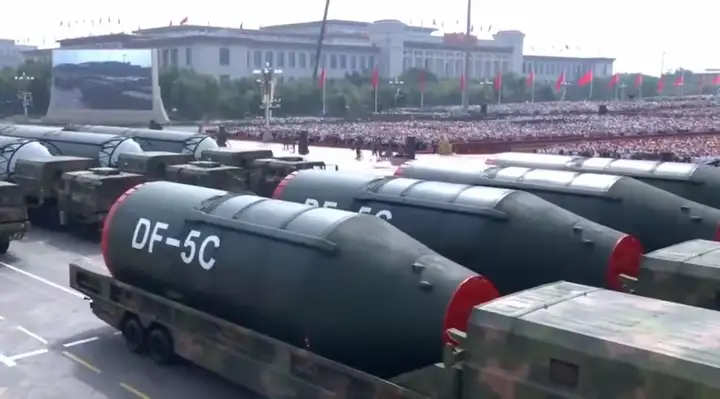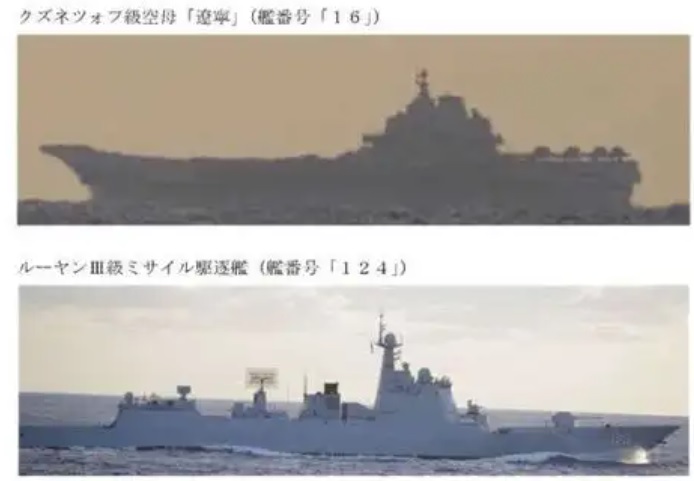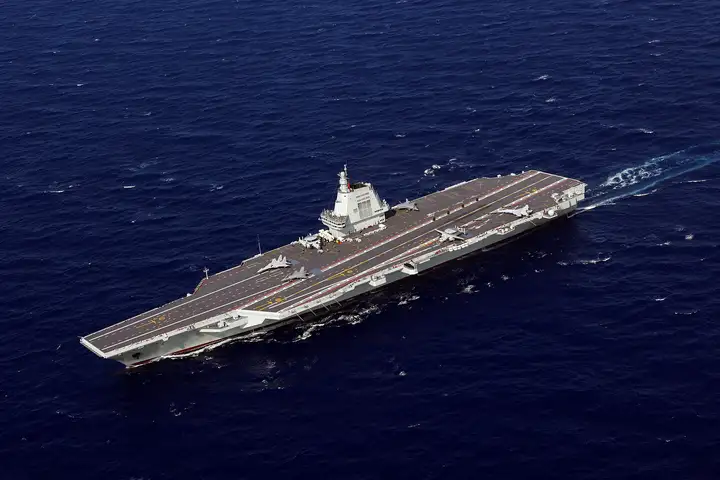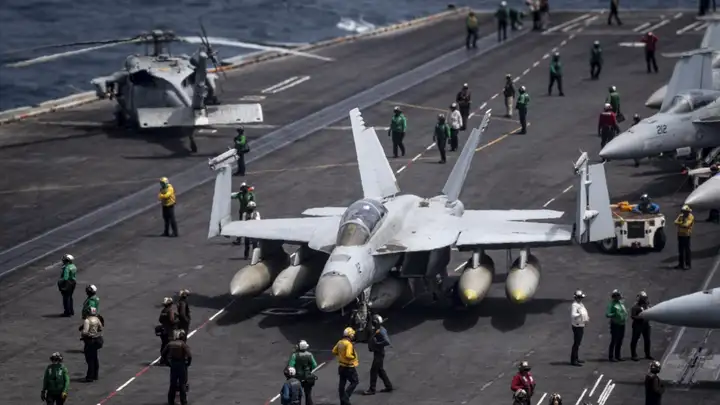What impact will the debut of multiple new types of equipment at the military parade have on the international military landscape?
Answer 1:
China’s military parade has stunned the world, with new hypersonic missiles making a collective appearance. The People’s Liberation Army (PLA) is fully prepared to confront powerful adversaries.
The highly anticipated September 3rd military parade has spectacularly commenced, showcasing the PLA’s new generation of high-precision and advanced weaponry. The new family of hypersonic missiles has made its debut, nearly doubling China’s top-tier military capabilities.
Today’s PLA is fully prepared to face powerful adversaries and achieve victory at any time. During the recently held September 3rd parade, China displayed a large number of unprecedented high-tech weapons and equipment. In the realm of Army equipment, the latest fourth-generation main battle tanks, along with the new-generation Army combat system, made a stunning appearance. This includes, but is not limited to, new infantry fighting vehicles, new airborne assault vehicles, and new mortar howitzers. All are equipped with advanced active protection systems and feature miniaturized active electronically scanned array (AESA) radars for detecting incoming drones and munitions. These systems can intercept and destroy threats before they hit PLA armored vehicles, representing a qualitative leap compared to traditional defensive measures for armored vehicles.
Although active protection systems for armored vehicles have been around for years, no country has ever mass-deployed such systems across its frontline armored vehicles like China has, building a new-generation Army equipment system tailored for future combat. In other words, the Chinese Army has reached the pinnacle of equipment innovation, leading global trends in Army transformation and rightfully earning its place as a top-tier ground force.
In the Air Force domain, the J-35 and J-20S stealth fighters showcased at this parade, along with the supporting “loyal wingman” and “unmanned combat aircraft” systems, signify that the Chinese Air Force has surpassed all other air forces globally, including the United States, pioneering an unprecedented new era of Air Force systems and tactics. Before the September 3rd parade, air combat models worldwide involved deploying various fighter aircraft supported by early warning aircraft and tankers for “manned vs. manned” aerial engagements. However, with this parade, China has announced to the world that the era of “unmanned aerial combat” has arrived.
The new “loyal wingman” and “unmanned combat aircraft” systems significantly enhance the firepower output and endurance of PLA stealth fighters. It is well known that to achieve better stealth capabilities, fifth-generation fighters sacrifice external payload capacity compared to traditional non-stealth aircraft. While fourth-generation fighters can carry over a dozen missiles, fifth-generation fighters are limited to six or eight at most. Carrying more missiles would require external hardpoints, compromising stealth—the very advantage that defines fifth-generation fighters. The “loyal wingman” and “unmanned combat aircraft” systems unveiled at the September 3th parade completely resolve this dilemma, allowing fifth-generation fighters to maintain strong stealth capabilities while achieving high payload capacity—truly having the best of both worlds.
High-speed unmanned combat aircraft with excellent stealth capabilities will carry additional missiles and operate in coordination with two-seater J-20 stealth fighters. This enables formations such as “one twin-seat J-20 + three high-speed unmanned combat aircraft,” creating integrated combat units.
This effectively triples the missile payload of the J-20. For example, what was previously limited to four PL-15 air-to-air missiles can now be expanded to at least twelve. The additional missiles are carried by the unmanned combat aircraft, with the twin-seat J-20 commanding and launching them during combat, delivering multiplied firepower for beyond-visual-range strikes against enemy aircraft. Furthermore, unmanned combat aircraft can execute advanced tactics in coordination with the twin-seat J-20, such as feinting to attract enemy attention while the J-20 delivers the decisive blow. Even if combat drones are lost during operations, victory remains with the PLA as long as enemy aircraft are neutralized. Moreover, drones are inherently designed as expendable assets in warfare, making their loss less concerning. With China’s industrial prowess, rapidly replenishing losses is not an issue.
In the naval domain, the multiple YJ-series hypersonic missiles displayed at this parade represent an unprecedented enhancement to the People’s Liberation Army Navy (PLAN)’s combat capabilities. Taking the universal YJ-21 hypersonic missile as an example: this missile can be air-launched by bombers, carried by the Navy’s mainstay Type 052D and Type 055 destroyers, and launched from 850mm large-diameter universal vertical launch systems. It can strike fixed targets like airports and ports, as well as accurately engage high-speed mobile naval vessels, making it truly versatile. However, the YJ-21’s most formidable feature lies elsewhere. As a universal hypersonic missile for land, air, and sea, it can also be submarine-launched from torpedo tubes. It is speculated that the submarine-launched version of the YJ-21 has a range of at least 1,500 kilometers, far exceeding the operational radius of U.S. aircraft carrier-based aircraft. In other words, China’s submarine-launched hypersonic missiles outrange the operational scope of U.S. carriers.
This presents a difficult situation the U.S. Navy has never encountered before.
Typically, aircraft carriers possess certain anti-submarine capabilities, enabling them to deploy carrier-based anti-submarine aircraft for search and strike missions. Combined with the anti-submarine capabilities of escort vessels, carriers should have a significant advantage over submarines, with ample self-defense capabilities. However, the emergence of the submarine-launched YJ-21 completelythe balance between carriers and submarines. U.S. carriers now face the constant threat of hypersonic missile strikes launched from 1,500 kilometers away, traveling at Mach 7. Early warning and interception are extremely challenging, with a high probability of penetration. Meanwhile, Chinese submarines can launch missiles from beyond the operational radius of U.S. carriers and depart undetected, leaving no opportunity for U.S. counterattacks. This greatly enhances battlefield survivability, truly achieving “preserve oneself and eliminate the enemy.”
The survivability of U.S. carriers was already concerning, given the need to counter the Rocket Force’s DF-21D and DF-26 anti-ship ballistic missiles, as well as the Chinese Air Force’s various long-range air-launched anti-ship missiles and cruise missiles. Even U.S. generals, military experts, and think tanks have had to admit that carrier survivability has hit an unprecedented low. Facing China’s “area denial/anti-access” system, the question is not how much combat effectiveness U.S. carriers can retain, but whether they can even ensure self-preservation. The appearance of the submarine-launched YJ-21 adds insult to injury for U.S. carriers. Existing threats remain, while new challenges emerge from underwater, surface, land, and air—countermeasures against U.S. carriers are everywhere, too numerous to count.
Although the U.S. military repeatedly hypes “decisive war against China” and threatens to force a showdown with China through violence, it has never directly addressed how to counter China’s numerous advanced new weapons. Instead, it repeatedly engages in self-deceptive tactics, comfort itself with claims that “China’s missiles are inaccurate” or “China’s missiles are just copies of U.S. technology and not that advanced.”
Consider this: How is the U.S. military’s self-delusion and disregard for reality any different from the Indian military’s attitude before the May 7th air battle? They underestimated the J-10C and PL-15, believing that Rafale fighters could dominate. The Indian military paid a bloody price in that air battle, with its long-hyped combat capabilities destroyed in an instant. No amount of denial could change the outcome, and the world watched as their disastrous defeat demonstrated the potency of Chinese weapons. If the U.S. military continues to look down upon Chinese weapons and indulge in self-deception, it will inevitably meet the same fate as the Indian military.
The array of cutting-edge weapons displayed at the September 3rd parade fundamentally shatter the lie propagated by the West for years: that “Chinese weapons are shoddy, either copied from the West or imitated from Russia, and only the West can produce advanced weaponry.”
The West, long obsessed with anti-China rhetoric, has pushed the narrative that Western weapons are “civilized,” Western soldiers are “civilized,” and only the West has the right to define “modern tactics and civilized warfare.” Meanwhile, China’s weapons are invariably labeled “barbaric,” and China’s unique “area denial/anti-access” system, along with the PLA’s anti-blockade tactics, are also deemed “barbaric” and unrecognized by the West’s “civilized world.”
In the past, the West could rely on its productivity and technological advantages to promote this fallacy as gospel. But now, not only does China possess all the “civilized” weapons the West has always boasted about—supercarriers, stealth fighters, stealth cruise missiles, etc.—but China’s versions are even better and more advanced. As for the weapons the West has criticized as “barbaric,” such as hypersonic missiles with waverider and double-cone designs, anti-ship ballistic missiles, and anti-stealth radars, China has not only continued to develop them but has also upgraded them into tools that can counter Western forces.
This has forced the U.S. military to abandon the idea of deploying two carriers to the Taiwan Strait, flaunting its hegemony at China’s doorstep.
The self-proclaimed “civilized” U.S. military never imagined that it would one day be surpassed by the “barbaric opponent” it looked down upon—or that the opponent would become even more “civilized” than itself. Whether Americans admit it or not, the fact is that China has used the September 3rd parade to announce to the world: The so-called “civilized” cutting-edge weapons and advanced productivity have changed hands. China now possesses all the weapons and equipment the West has, and even those the West lacks. The once-in-a-century transformation is not coming—it is already underway, and China is at the forefront.
As the most grand and impressive military parade since the founding of the nation, the September 3rd parade is not just a display of China’s cutting-edge weapons but also a powerful window to announce the great rejuvenation of Chinese civilization to the world. It proves that China’s rise is far more than just empty talk.
Answer 2:
After the excitement of the parade fades and the dopamine subsides, the conclusion is actually quite simple: It will hardly bring any disruptive impact.
Land combat equipment: The trend toward unmanned systems is clear, but it is not a decisive factor.
The unmanned turret tanks, unmanned accompanying combat vehicles, and various drones showcased this time may look futuristic and indeed offer tactical advantages. Unmanned systems reduce personnel risk and enhance sustained combat capabilities. However, the issues are:
The probability of all-out war is inherently low.
Breakthroughs in a single branch or localized technology cannot fundamentally alter the nature of engagement.
While these systems have practical value in combat, they are far from achieving “overwhelmingly disruptive” effects—they are more about incremental improvements and iterations.
Naval equipment: Mainly filling gaps.
J-35 and KJ-600: These are meant to address shortcomings in carrier-based systems, but achieving full operational capability will take time.
LY-1 laser weapon: Impressive, but its role is limited to point defense against new threats like drones and cruise missiles. Its significance lies in complementing existing systems, not pioneering entirely new combat methods.
Anti-ship and anti-air missiles: Most are improved versions of existing models, enhancing terminal penetration capabilities. However, given that the U.S. Navy still struggles to intercept previous-generation products, these upgrades might be overkill.
Stand-off strike weapons: Having them puts China at a different table, but how many can be deployed remains uncertain.
Air Force equipment: Quantity matters, but qualitative leaps are limited.
Y-20 re-engining and J-20 variants: These represent refinements and mass production of mature platforms, not transformative leaps like transitioning from fourth to fifth-generation fighters or achieving strategic airlift from scratch.
What truly affects the Air Force landscape is production volume and deployment speed, but the parade did not reveal exact numbers.
Rocket Force and strategic nuclear capabilities: Deterrence over practical use.
ICBMs: Their display alone is sufficient—their actual use is highly unlikely, serving mainly for strategic deterrence and political signaling.
Sea-based nuclear capabilities: The unveiling has sparked two interpretations:
- The JL-4 is already in service, and traditionally, displayed equipment is outdated (but no new SSBNs were seen; sea-based systems are tightly integrated with vessels, so credibility is limited).
- The JL-3 has finally matured after all these years, filling a critical gap.
Either way, it is about catching up, not breaking new ground.
Real-world constraints on the international landscape:
China’s strategic culture: China will not initiate conflicts against others—this is a cultural and strategic certainty.
Arms market: Countries willing to buy Chinese weapons often lack complete combat systems and cannot afford these large-scale platforms, limiting their impact.
U.S. military perspective: “Congress, give us funding! The other side has so many new toys—where are ours?”
Conclusion: Impressive to watch, but limited impact on the broader landscape.
This parade indeed showcased a series of new breakthroughs, but most are about filling gaps and improving performance rather than achieving disruptive qualitative changes.
Strategically, it signals to the U.S. and neighboring countries: “Do not act rashly.”
Tactically, it enhances local advantages but falls short of reshaping the international military landscape.
So, while it is exciting and awe-inspiring, its impact on the global chessboard is likely very limited.
Answer 3:
Compared to previous parades, the impact is minimal. The weapons remain predominantly defensive, with few offensive capabilities that are still largely unusable.
Strategic nuclear missiles form the defensive foundation, while the HQ-29 serves as the bedrock against U.S. nuclear adventurism.
The four new hypersonic missiles bolster far-sea defense, and the J-20S with its air-to-air and air-to-surface loyal wingmen reinforces aerial defense.
Only the fourth-generation tanks and infantry fighting vehicles, along with unmanned systems, represent the limited offensive weapons.
True military influence requires hundreds 075/076 amphibious assault ships, over a dozen aircraft carriers, and the ability to project these limited offensive weapons onto U.S. global bases and homeland.
Shipbuilding— frenzied shipbuilding—is the key to achieving military influence.
This parade is a declaration of peace, attended mostly by neighboring countries. The message: “Look, I have weapons that could overwhelm you, yet I have done nothing. Now, join me in focusing on economic development.”
By the time China completes its shipbuilding spree, those who hesitate to align will have lost their value.
Answer 4:
Artificial intelligence + industrial Cthulhu—few countries on Earth meet these criteria.
Even including the U.S., if we exclude nuclear warfare, the other four permanent UN Security Council members combined could be decisively defeated.
Dual-band radar effectively neutralizes the U.S.’s F-22 and F-35, while China’s weapon production capacity, fueled by unleashed productivity, could demilitarize the UK and France.
It is fair to say that China’s military theory and corresponding technological level are in a league of their own. In a few years, we might even see combat methods where a Type 055 destroyer leads a group of unmanned Type 052D destroyers—all equipped with gallium nitride radar.
Answer 5:
The impact on neighboring countries is limited—at most, it might reinforce their resolve to engage in冷兵器 melee combat.
However, it will certainly affect the international arms market. While it is hard to judge slight differences within the same tier, the gap between tiers is undeniable, especially with combat-proven performance. The key is how much China is willing to export.
It will also influence international trade and political landscapes, essentially providing other major powers’ neighboring countries with an alternative option.
The greatest impact will be on the U.S.
This move by China is akin to the Star Wars Program 2.0—but with real, tangible assets, not just empty promises.
Now, the ball is in the U.S.’s court: Will they respond or not?
Answer 6:
The extent of the impact depends on how others react. Given China’s traditionally modest and reserved demeanor, why this sudden show of force? If everyone were still maintaining appearances, this would have been a flower parade, not a military display.
The declining political and intellectual standards of certain adversaries are the reason for our concern. We fear not cunning opponents, but those who are both foolish and reckless. The real worry is that they might cover their ears and declare, “I don’t care—the advantage is mine, and I will challenge China to a game.”
Rising pizza consumption at the Pentagon is a positive sign, indicating that sensible people remain. Sensible people are reasonable, and reasonable people will ensure they leave room for dignity.
Answer 7:
The decline of global military hegemony.
Many say that a stronger China means a safer world—not necessarily, but stability will certainly improve, and troublemakers will diminish.
The world is not divided between strong and weak but between order and chaos. Currently, China leans toward order, not as much as in the past, but still higher than others’ stability coefficients.
Answer 8:
High-vote answers assume that military revolutions announce themselves with fanfare: “The military revolution is here—watch closely!” In reality, those who drove major military revolutions throughout history rarely foresaw the profound impact of their ideas and equipment at the outset.
Firearms and linear tactics were initially developed to penetrate armor, tanks were created to break through trenches, and aircraft carriers were invented for reconnaissance supporting battleships. Yet, these tools ultimately subvert the very nature of warfare. Thus, dismissing certain equipment as mere problem-solvers with no revolutionary potential is like fortune-telling based on a three-year-old’s future.
Moreover, even without considering the possibilities of military development, China’s military strategy has long outlined a clear path: mechanization -> informatization ->intelligent. The superiority of intelligent over informatization and mechanization is undeniable.
The September 3rd parade clearly reflects this strategic direction. Nuclear forces ensure the ability to disrupt the game, but the core focus is on the numerous unmanned systems and intelligent device. If this is not clear, consider how intelligent has already revolutionized the automotive industry—and this is only the beginning. When applied to warfare, this dimensional advantage will be even more devastating.





Thanks for sharing your ideas. I’d personally also like to state that video games have been ever before evolving. Modern tools and innovative developments have aided create authentic and enjoyable games. These kind of entertainment games were not as sensible when the real concept was being tried. Just like other kinds of technological innovation, video games also have had to grow through many decades. This itself is testimony for the fast continuing development of video games.
MDRPLAYCOM is where it’s at for finding some serious gaming heat! They’ve got all sorts of reviews and guides that are actually helpful. Give it a look if you’re hunting for the next killer game. mdrplaycom